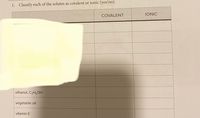
Chemistry
10th Edition
ISBN: 9781305957404
Author: Steven S. Zumdahl, Susan A. Zumdahl, Donald J. DeCoste
Publisher: Cengage Learning
expand_more
expand_more
format_list_bulleted
Concept explainers
Question

Transcribed Image Text:1. Classify each of the solutes as covalent or ionic (yes/no).
COVALENT
IONIC
ethanol, C2H5OH
vegetable oil
vitamin E
Expert Solution
This question has been solved!
Explore an expertly crafted, step-by-step solution for a thorough understanding of key concepts.
Step by stepSolved in 2 steps with 2 images

Knowledge Booster
Learn more about
Need a deep-dive on the concept behind this application? Look no further. Learn more about this topic, chemistry and related others by exploring similar questions and additional content below.Similar questions
- [References] A serving size of nine cookies contains 7 g of fat, 24 g of carbohydrates, and 9 g of protein. If walking 1 mile consumes 170 kJ of energy, how many miles must you walk to burn off enough calories to eat nine cookies? Assume the energy content of fats, carbohydrates, and proteins are 8 kcal/g, 4 kcal/g, and 4 kcal/g, respectively. 1 cal = 4.184 J. miles Submit Answer Try Another Version 3 item attempts remainingarrow_forward3) How many liters of combusted propane (C3H8; 44 g/mol) are required to heat a 100 kg steel pipe (specific heat of steel is 0.420 J/g°C), from room temperature (20°C) to its melting point of 1300°C? The density of propane is 0.493 g/mL.C3H8(g) + 5O2(g) → 3CO2(g) + 4H2O(l) ΔH=–2220 kJ /mol 4) How much energy is required to produce 1.9 grams of glucose (C6H12O6; 180 g/mol) from CO2 and H2O. Use the following combustion equation to help you answer the question?6CO2(g) + 6H2O(l) → C6H12O6(s) + 6O2(g) ΔH= 2900kJ 19) What volume of 0.12 M Na2SO4 will be required to react with 35 mL of 0.05 M CrCl6? 24) In an experiment when 100 g of C3H8 is combusted, 30 g of carbon dioxide resulted. What was the percent yield for the reaction?arrow_forwardIn what type of reaction is K2Cr2O7 a reactant?arrow_forward
- The 24 power plants in Baltimore metro area collectively emit about 40,300 metric tons of CO2 per day (www.carma.org), thereby increasing the level of greenhouse gases in this region. To counter this, environmentalists plan to plant trees in the area. How many moles of CO2 are emitted by these power plants every day? (1 ton =1000kg, molecular weight of CO2 is 44g) If on average 500 moles of glucose are synthesized by a tree each day, how many moles of CO2 can a single tree convert to glucose in a single day? How many trees need to be planted to reabsorb all the CO2 released into the atmosphere every day by these power plants? If a single tree occupies an average of 8.00 x 10-5 sq miles, what percent of the area of Baltimore city needs to be forested to counter the CO2 emitted from power plants alone? (total area of Baltimore city is 92.00 sq miles)arrow_forwardWhat are the pros and cons of the utilization of hydrogen gas as a source of energy? What are the obstacles that have prevented its widespread use?arrow_forwardGiven (8.79x10^6) moles of glucose, C6H12O6, calculate the mole of carbon dioxide, CO2, formed upon complete oxidation of the glucose. C6H12O6 + 6 O2 → 6 CO2 + 6 H2O Express your answer in three significant digits as moles. Note: Your answer is assumed to be reduced to the highest power possible.arrow_forward
- It took 16641664 J to raise the temperature of a sample of water from 12.512.5 °C to 34.534.5 °C. Convert 16641664 J to calories.arrow_forwardThe average adult human burns 2.00 × 10³ kcal per day in energy. What is this rate in kJ per hour? # 3 69 2.00 × 10³ 80 F3 ADD FACTOR S x( ) SA 4 1000 kcal/day 000 000 F4 0.001 % 5 1 cal 리니! F5 4184 < C 60 days hr ditv F6 2 4.184 = 2.01 * 106 1.15 * 105 kJ/hr kJ RA ANSWER MacBook Air & 7 349 F7 J 13 * 8 F8 24 kcal - RESET 5 9 20.0 min POR DE F9 O F10arrow_forwardWrite a balanced equation to show the reaction of gaseous ethane with gaseous oxygen to form carbon monoxide gas and water vapor. C2H6(g)+7 O(g) → 2 CO2(g)+3 H2O(g)C2H6(g)+7 O(g) → 2 CO2(g)+3 H2O(g) C2H6(g)+5 O(g) → 2 CO(g)+3 H2O(g)C2H6(g)+5 O(g) → 2 CO(g)+3 H2O(g) 2 C2H6(g)+7 O2(g) → 4 CO2(g)+6 H2O(g)2 C2H6(g)+7 O2(g) → 4 CO2(g)+6 H2O(g) 2 C2H6(g)+5 O2(g) → 4 CO(g)+6 H2O(g)2 C2H6(g)+5 O2(g) → 4 CO(g)+6 H2O(g) 2 CH3(g)+5 O(g) → 2 CO(g)+3 H2O(g)2 CH3(g)+5 O(g) → 2 CO(g)+3 H2O(g)arrow_forward
arrow_back_ios
arrow_forward_ios
Recommended textbooks for you
 ChemistryChemistryISBN:9781305957404Author:Steven S. Zumdahl, Susan A. Zumdahl, Donald J. DeCostePublisher:Cengage Learning
ChemistryChemistryISBN:9781305957404Author:Steven S. Zumdahl, Susan A. Zumdahl, Donald J. DeCostePublisher:Cengage Learning ChemistryChemistryISBN:9781259911156Author:Raymond Chang Dr., Jason Overby ProfessorPublisher:McGraw-Hill Education
ChemistryChemistryISBN:9781259911156Author:Raymond Chang Dr., Jason Overby ProfessorPublisher:McGraw-Hill Education Principles of Instrumental AnalysisChemistryISBN:9781305577213Author:Douglas A. Skoog, F. James Holler, Stanley R. CrouchPublisher:Cengage Learning
Principles of Instrumental AnalysisChemistryISBN:9781305577213Author:Douglas A. Skoog, F. James Holler, Stanley R. CrouchPublisher:Cengage Learning Organic ChemistryChemistryISBN:9780078021558Author:Janice Gorzynski Smith Dr.Publisher:McGraw-Hill Education
Organic ChemistryChemistryISBN:9780078021558Author:Janice Gorzynski Smith Dr.Publisher:McGraw-Hill Education Chemistry: Principles and ReactionsChemistryISBN:9781305079373Author:William L. Masterton, Cecile N. HurleyPublisher:Cengage Learning
Chemistry: Principles and ReactionsChemistryISBN:9781305079373Author:William L. Masterton, Cecile N. HurleyPublisher:Cengage Learning Elementary Principles of Chemical Processes, Bind...ChemistryISBN:9781118431221Author:Richard M. Felder, Ronald W. Rousseau, Lisa G. BullardPublisher:WILEY
Elementary Principles of Chemical Processes, Bind...ChemistryISBN:9781118431221Author:Richard M. Felder, Ronald W. Rousseau, Lisa G. BullardPublisher:WILEY

Chemistry
Chemistry
ISBN:9781305957404
Author:Steven S. Zumdahl, Susan A. Zumdahl, Donald J. DeCoste
Publisher:Cengage Learning

Chemistry
Chemistry
ISBN:9781259911156
Author:Raymond Chang Dr., Jason Overby Professor
Publisher:McGraw-Hill Education

Principles of Instrumental Analysis
Chemistry
ISBN:9781305577213
Author:Douglas A. Skoog, F. James Holler, Stanley R. Crouch
Publisher:Cengage Learning

Organic Chemistry
Chemistry
ISBN:9780078021558
Author:Janice Gorzynski Smith Dr.
Publisher:McGraw-Hill Education

Chemistry: Principles and Reactions
Chemistry
ISBN:9781305079373
Author:William L. Masterton, Cecile N. Hurley
Publisher:Cengage Learning

Elementary Principles of Chemical Processes, Bind...
Chemistry
ISBN:9781118431221
Author:Richard M. Felder, Ronald W. Rousseau, Lisa G. Bullard
Publisher:WILEY